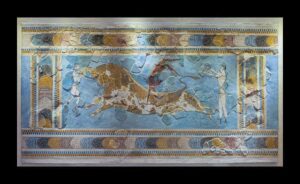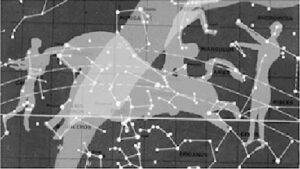Is the famous Cretan fresco denoting the stars around Taurus? William Glyn-Jones thinks it may be…

Cr. Heraklion Archaeological Museum CCO, Wikimedia Commons
The Bull Leaper fresco (p.16) from the palace of Knossos in Crete has always been a particular favourite of mine. The graceful power of the bull, with its sensuous flowing curves, the lithe beauty of the dark-limbed dancers, and the overall sense of movement combine to form a remarkable composition. My love of this painting has led me to draw a copy of it so as to experience it more intimately, and I was also driven to seek the original in the museum of Iraklion in Crete. When admiring the picture there is a feeling that the aesthetic aspect alone is enough, which is why it is particularly surprising to discover that there is a reason for the attitude of every limb.
The first level of deepening, beyond the aesthetic, comes from the obvious allegory, the one that fits with our idiom about ‘grabbing the bull by the horns’. Our challenges can take us higher if we are willing to face them. Contemplating the image, it also occurred to me that the shape of Crete herself (above) is similar to that of the bull, with undercarriage, tail, and two horns in the northeast corner. The bull culture arose in the Age of Taurus, and really if the seeding of the culture was being planned a better time and place could not be found. (The Age of Taurus is when the Spring Equinox Sun is in Taurus.)
An interesting feature of the painting is that if the Before dancer was to jump and complete his leap, he would not land facing in the direction that the After dancer is facing behind the bull. When we complete a somersault, by definition we end up facing the direction in which we were facing when we leapt. For the After dancer to land the way he has in the painting, he would have to have done a backwards somersault over the bull – clearly not a feasible option even for the most accomplished acrobat. The painting was obviously of royal or priestly commission, so can this really be regarded as a mistake, or was the painter working to some other agenda that is not immediately obvious?
As we look closer some other questions are raised. Is not the bull rather long with stumpy little legs? Isn’t its head rather small and horse-like? Isn’t the After dancer excessively tall? And isn’t the Before dancer rather close to the bull if he expects to be able to leap over him? What is more, why do the arms of the During dancer reach so far down the sides of the bull, rather than resting on the top of his back where some decent purchase could be gained? Art historians are also curious about the ‘floating style’ of such art. The figures are not placed on the ground, but rather just float in the blue. We could pass over these anomalies by saying that the picture is ‘highly stylized’, but it seems to me there must be more to it.
Recently, while thinking about another matter, I was pouring over a chart of the constellations. As I looked at Taurus, a fancy entered my mind. What if the bull leapers from the fresco were present in the stars as other constellations around the bull? My eyes widened when I checked the hypothesis, and saw, to my great amazement, that it bore out (see p.17)!
There was, above the bull, his every angle mapped out by Perseus. His right hand is the Hyades, and his other arm goes through the Pleiades. There was the whipping tail of the bull, as the constellation of Aries. And there behind the bull was After, his gymnastically raised arms prescribed by a portion of Pegasus, his head with its dark and tightly coiled tresses present as the Andromeda Galaxy – a particularly nice touch. The bull’s head, tucked down towards its powerful chest, shows a perfect correlation with Gemini, and the Before dancer has the contours of his arched back, broad chest, slim waist and bent back leg delineated by the Crab sign. The Bull has broken the limits of its conventional constellation as we know it now, and the tips of its horns are almost intruding into Leo! The eye of the Bull is a bright star – another beautiful touch. (The white lines in the diagram are not added by me, they are the standard constellation lines which were there in the star-map.)

The proportions are not an exact correlation, but we must bear in mind that the fresco was put back together in recent times from a collection of fragments, and, like the reconstruction of Knossos as a whole, total accuracy was not possible. However, the match is close enough for the resonance principle to be operative, so is it possible that the painting receives its exquisite elegance from star resonance, explaining how so simple a picture appears so very beautiful? How might this magic work?
The best theory to call up here is that of morphogenic resonance. The theory is that of biologist Rupert Sheldrake, and he formulated it to explain the amazing results of certain animal experiments. The most famous case is that of the milk-bottle opening blue tits. One particularly inspired blue tit found its way through the first lid, and then another, and then another, until soon the craze had spread across Europe. What was astounding was that the behavior spread too quickly to have been passed on from bird to bird. Even more amazing, it reappeared after the war, during which time the milk bottles were not delivered, even though the war lasted longer than the life span of the blue tit. This fact is the key to the inner wisdom of the story of Noah and the Ark.
Sheldrake’s theory makes perfect intuitive sense to the metaphysician, and it basically says that like forms are in resonance. Blue tits are all of like form. There are many other experiments that support the theory, such as successive generations of unrelated rats who learn tasks with increasing rapidity.
It’s not difficult to see how this phenomenon applies to the Bull Leaper Fresco. The painting shares its form with a portion of the stars. Now the pattern of the stars is different seen from other places in the Galaxy, but what remains fairly fixed over very long periods of time is the pattern as seen from the Earth. In fact the star patterns are some of the most permanent forms available to the successive generations of humanity. As the patterns of the stars are gazed up at and mythologized by generation after generation for millions of years, clearly some very strong morphogenic patterns are going to arise. When we look at a painting like the Bull Leaper fresco, we are perceiving the subtle non-physical morphogenic field that is around the work, and tapping into the wonder-bank of a billion stargazers! The Zodiac is a record of human wonder.
Barbara Hand-Clow’s channeled book, The Pleiadian Agenda, contains some very interesting information on these non-physical morphic light fields. The stronger the love and appreciation for an artifact, the stronger the light-fields, and these fields in turn help the artifact to stay in form in 3d. This suggests an interesting flip in the way we think about great works. Hancock has shown how many of the ancient structures that have survived are aligned to the stars. Is it that they have survived for so long because they have resonance with the strong morphogenic patterns of the constellations? Hancock and Bauval maintain that the Sphinx dates back to 10,500 B.C., and I suspect that that may be an extremely conservative estimate. If it is this old, is it not possible that the Hall of Records that it is said to guard it is actually of a morphogenic nature, and is essentially a record of the passionate feelings of appreciation that have kept the Sphinx in form for the last 12,000 years? We can stop digging holes on the Giza plateau like squirrels searching for our nuts. The treasures are there in the morphic fields, and the best we can do is to conserve the site with loving care. This raises another very interesting question: is it the case that, rather than the Sphinx being a product of Egyptian culture, Egyptian culture appeared, or rather reappeared, out of the morphogenic fields of the Sphinx?? Of course the Sphinx has its own resonance with the constellation of Leo.
The Sphinx, as a very ancient monument, is a keeper of treasures that belong to humanity – because human perceptions put them there. Some researchers feel that ancient humans could not have been responsible for some of the huge stone structures of antiquity, but remember that the answer to the riddle of the Sphinx – what creature walks on 4 legs, then 2 legs, then 3? – is Man. Man is the heart of the mystery. We have gilded the stars and rocks with a wonder that comes from inside our human breasts.
Myths frequently involve characters who have been placed in the stars. Is it in fact truer to say that the stories have become myths because they resonate with the constellations? Strong morphogenic light-fields create lasting physical forms. What would Darwin have to say about that? Is this why the Zodiac is a wheel of animals? The subject of the Cretan bull-leaper fresco is highly appropriate, for Taurus is the sign of taking care, particularly of material things. It is the sign of physical fixity – permanence of form.
Published in NE91, Autumn 2002, p15-18